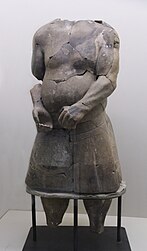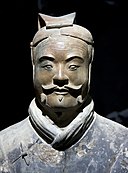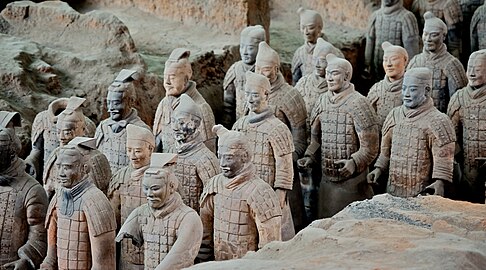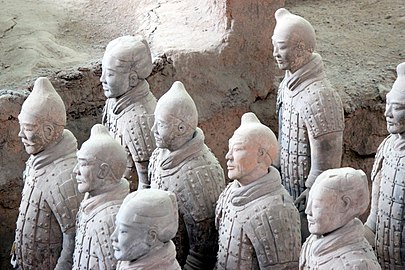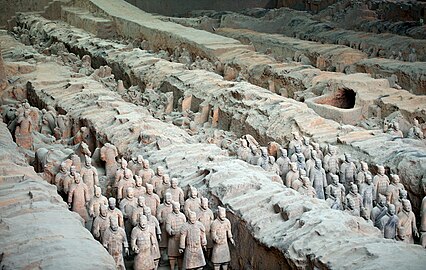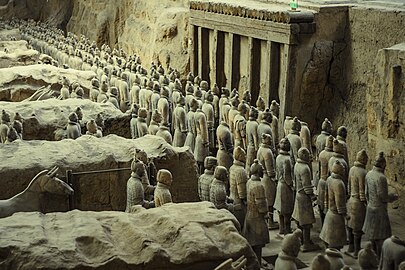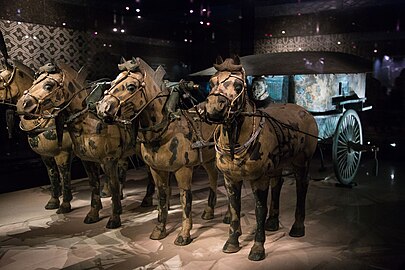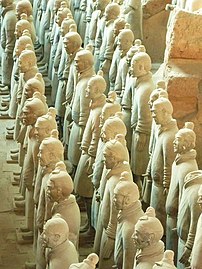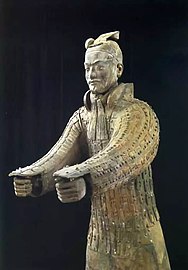Terracotta Army
| UNESCO World Heritage Site | |
|---|---|
 | |
| Location | Lintong District, Xi'an, Shaanxi, China |
| Criteria | Cultural: i, iii, iv, vi |
| Reference | 441 |
| Inscription | 1987 (11th Session) |
| Website | bmy.com.cn |
| Coordinates | 34°23′06″N 109°16′23″E / 34.38500°N 109.27306°E |
| Terracotta Army | |||||||||||||||||||||
|---|---|---|---|---|---|---|---|---|---|---|---|---|---|---|---|---|---|---|---|---|---|
| Simplified Chinese | 兵马俑 | ||||||||||||||||||||
| Traditional Chinese | 兵馬俑 | ||||||||||||||||||||
| Literal meaning | Soldier and horse tomb-figurines | ||||||||||||||||||||
| |||||||||||||||||||||
The Terracotta Army is a collection of terracotta sculptures depicting the armies of Qin Shi Huang, the first emperor of China. It is a form of funerary art buried with the emperor in 210–209 BCE with the purpose of protecting him in his afterlife.
The figures, dating from approximately the late 200s BCE,[1] were discovered in 1974 by local farmers in Lintong County, outside Xi'an, Shaanxi, China. The figures vary in height according to their rank, the tallest being the generals. The figures include warriors, chariots and horses. Estimates from 2007 were that the three pits containing the Terracotta Army hold more than 8,000 soldiers, 130 chariots with 520 horses, and 150 cavalry horses, the majority of which remain in situ in the pits near Qin Shi Huang's mausoleum.[2] Other, non-military terracotta figures have since been found in other pits, including those of officials, acrobats, strongmen, and musicians.[3]
History
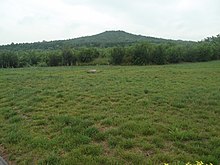

 ). The central tomb itself has yet to be excavated.[4]
). The central tomb itself has yet to be excavated.[4]The construction of the tomb was described by the historian Sima Qian (145–90 BCE) in the Records of the Grand Historian, the first of China's 24 dynastic histories, which was written a century after the mausoleum's completion. Work on the mausoleum began in 246 BCE, soon after Emperor Qin (then aged 13) succeeded his father as King of Qin, and the project eventually involved 700,000 conscripted workers.[5][6] Geographer Li Daoyuan, writing six centuries after the first emperor's death, recorded in Shui Jing Zhu that Mount Li was a favoured location due to its auspicious geology: "famed for its jade mines, its northern side was rich in gold, and its southern side rich in beautiful jade; the first emperor, covetous of its fine reputation, therefore chose to be buried there".[7][8]
Sima Qian wrote that the first emperor was buried with palaces, towers, officials, valuable artifacts and wondrous objects. According to this famous account, 100 flowing rivers were simulated using mercury, and above them the ceiling was decorated with heavenly bodies, below which lay the features of the lands of China which the emperor had unified. Some translations of this passage refer to "models" or "imitations"; however, those words were not used in the original text, which also makes no mention of the terracotta army.[5][9] Although these elements of Sima Qian's account on the structure of the mausoleum have been seen as credulous in pre-modern assessments, the detection of high levels of mercury that were found in the soil of the tomb mound following the discovery of the mausoleum site have since given credence to Sima Qian's account.[10] Additionally, the Emperor is well documented for building monumental statues in human form during his reign, such as the Twelve Metal Colossi, which were a series of contemporaneous statues that are now lost but have been noted in historical records.[11]
Later historical accounts have suggested that the mausoleum complex and tomb itself had been looted by Xiang Yu, a contender for the throne after the death of the first emperor.[12][13][14] However, there are indications that the tomb itself may not have been plundered.[15]
Discovery
The Terracotta Army was discovered on 29 March 1974 by a group of farmers—Yang Zhifa, his five brothers, and neighbour Wang Puzhi—who were digging a well approximately 1.5 km (0.93 mi) east of the Qin Emperor's tomb mound at Mount Li (Lishan),[16][17][18][19] a region riddled with underground springs and watercourses. For centuries, occasional reports mentioned pieces of terracotta figures and fragments of the Qin necropolis – roofing tiles, bricks and chunks of masonry.[20] This discovery prompted Chinese archaeologists, including Zhao Kangmin, to investigate,[21] revealing the largest pottery figurine group ever found. A museum complex has since been constructed over the area, the largest pit being enclosed by a roofed structure.[22]
Necropolis


The Terracotta Army is part of a much larger necropolis. Ground-penetrating radar and core sampling have measured the area to be approximately 98 square kilometers (38 square miles).[23]
The necropolis was constructed as a microcosm of the emperor's imperial palace or compound,[citation needed] and covers a large area around the tomb mound of the first emperor. The earthen tomb mound is located at the foot of Mount Li and built in a pyramidal shape,[24] and is surrounded by two solidly built rammed earth walls with gateway entrances. The necropolis consists of several offices, halls, stables, other structures as well as an imperial park placed around the tomb mound.[citation needed]
The warriors stand guard to the east of the tomb. Up to 5 m (16 ft) of reddish, sandy soil had accumulated over the site in the two millennia following its construction, but archaeologists found evidence of earlier disturbances at the site. During the excavations near the Mount Li burial mound, archaeologists found several graves dating from the 18th and 19th centuries, where diggers had apparently struck terracotta fragments. These were discarded as worthless and used along with soil to backfill the excavations.[25]
Tomb
The tomb appears to be a hermetically sealed space approximately 100 by 75 metres (328 ft × 246 ft).[26][27] The tomb remains unopened, possibly due to concerns over preservation of its artifacts.[26] For example, after the excavation of the Terracotta Army, the painted surface present on some terracotta figures began to flake and fade.[28] The lacquer covering the paint can curl in fifteen seconds once exposed to Xi'an's dry air and can flake off in just four minutes.[29]
Excavation site

Pits

Four main pits approximately 7 m (23 ft) deep have since been uncovered in the site excavations.[30][31] These are located approximately 1.5 km (0.93 mi) east of the burial mound. The soldiers within were laid out as if to protect the tomb from the east, where the Qin Emperor's conquered states lay, and were discovered 7 m below the excavation level.[32]
Pit 1
Pit 1, which is 230 m (750 ft) long and 62 m (203 ft) wide,[33] contains the main army of more than 3,000 figures.[34] It is the largest of the four pits and has eleven parallel corridors, most more than 3 m (10 ft) wide and paved with small bricks with a wooden ceiling supported by large beams and posts.[32] This design was also used for the tombs of nobles and would have resembled palace hallways when built. The wooden ceilings were covered with reed mats and layers of clay for waterproofing, and then mounded with more soil raising them about 2 to 3 m (6 ft 7 in to 9 ft 10 in) above the surrounding ground level when completed.[35]
Others
Pit 2 has cavalry and infantry units as well as war chariots and is thought to represent a military guard. Pit 3 is the command post, with high-ranking officers and a war chariot. Pit 4 is empty, perhaps left unfinished by its builders.
Some of the figures in Pits 1 and 2 show fire damage, while remains of burnt ceiling rafters have also been found.[36] These, together with the missing weapons, have been taken as evidence of the reported looting by Xiang Yu and the subsequent burning of the site, which is thought to have caused the roof to collapse and crush the army figures below. The terracotta figures currently on display have been restored from the fragments.
Other pits that formed the necropolis have also been excavated.[37] These pits lie within and outside the walls surrounding the tomb mound. They variously contain bronze carriages, terracotta figures of entertainers such as acrobats and strongmen, officials, stone armour suits, burial sites of horses, rare animals and labourers, as well as bronze cranes and ducks set in an underground park.[3]
Warrior figures
Types and appearance

The warriors
The terracotta figures are life-sized, typically ranging from 175 cm (5.74 ft) to about 200 cm (6.6 ft) (the officers are typically taller). They vary in height, uniform, and hairstyle in accordance with their portrayed rank. Their faces appear to be different for each individual figure, scholars have identified 10 base facial forms which were then further developed to give each figure individuality in terms of facial morphology.[38] The figures are of these general types: armored infantry; unarmored infantry; cavalrymen who wear a pillbox hat; helmeted drivers of chariots with more armor protection; spear-carrying charioteers; kneeling crossbowmen or archers who are armored; standing archers who are not; as well as generals and other lower-ranking officers.[39] There are, however, many variations in the uniforms within the ranks: for example, some may wear shin pads while others not; they may wear either long or short trousers, some of which may be padded; and their body armors vary depending on rank, function, and position in formation.[40] There are also terracotta horses placed among the warrior figures.
Originally, the figures were painted with ground precious stones, intensely fired bones (white), pigments of iron oxide (dark red), cinnabar (red), malachite (green), azurite (blue), charcoal (black), cinnabar barium copper silicate mix (Chinese purple or Han purple), tree sap from a nearby source (more than likely from the Chinese lacquer tree) (brown),[41] and other colors including pink, lilac, red, white,[42] and one unidentified color.[41] The colored lacquer finish and individual facial features would have given the figures a realistic feel, with eyebrows and facial hair in black and the faces done in pink.[43]
However, in Xi'an's dry climate, much of the color coating would flake off in less than four minutes after removing the mud surrounding the army.[41]
The acrobats
Excavations in Pit K9901 have uncovered in 1999 a series of associated terracotta sculptures that have been dubbed "The Acrobats", which have been remarked to display an advanced understanding of human anatomy.[45] The original function of these statues remains unclear, but they have been described as either potentially acrobat or dancer figures. The number of these figures uncovered thus far are relatively few compared to the more noted warrior figures, with the total discovered probably numbering a dozen. The figures are bare with the exception of a loincloth as dress. These figures are very vivid and less stereotypical than the soldiers, especially through the dynamic treatment of the musculature and bone joints.[45] Some of the men are very lean, while others have massive bodies. Several of them are shown in the process of moving or making gestures. These terracotta statues demonstrate an advanced mastery of the depiction of the shapes and proportions of the human body.[44]
Eleven of such figurines from Pit K9901 have since been subsequently unearthed with seven of them found in a degree of preservation that made them capable of being largely reconstructed from their fragment shards.[46]
Speculations on possible influences
Since the time of their discovery, the figures have been noted for their exceptional stylistic realism and individualism, with assessments having found that no two figures share the exact same features.[47][48] The earliest note on this aspect was that of 20th century art historian German Hafner who, in 1986, was the first to speculate on a possible Hellenistic link to these sculptures due to the unusual display of naturalism relative to general Qin era sculpture: "the art of the terracotta army originated from Western contact".[49] This idea was also generally supported by Duan Qingbo, site chief archaeologist from 1998 to 2006, though noting that "the only thing" in extant archaeology which may hold a close similarity to the figures in terms of their artistic style is that of the later 1st century BCE Central Asian Khalchayan statuary.[50] Li Xiuzhen, senior site archaeologist,[51] also acknowledged the possibility of Hellenistic influences, stating: "we now think the Terracotta Army, the acrobats and the bronze sculptures found on site were inspired by ancient Greek sculptures and art."[52] She later also asserted ultimate Chinese authorship: "the terracotta warriors may be inspired by Western culture, but were uniquely made by the Chinese."[53]
Others have argued that such speculations rest on flawed and old Eurocentric ideas that assumed other civilizations were incapable of sophisticated artistry and thus foreign artistry must be seen through Western traditions, with site archaeologist Zhang Weixing stating that "there is no substantial evidence at all" for any such linkage.[53] Raoul McLaughlin, an independent researcher on Roman trade, stated that there is no Greek influence on the Terracotta Army and emphasized the differences in artisanship, construction material, and symbology.[54] Darryl Wilkinson of Dartmouth College has instead argued that the Qin era display of sculptural naturalism, alongside that of the pre-Columbian Moche culture in Peru, indicate that "the Greeks did not invent naturalism" and that "sculptural naturalism is not the product of any one culture's civilizational 'genius.'"[55]
Construction

The terracotta army figures were manufactured in workshops by government laborers and local craftsmen using local materials. Heads, arms, legs, and torsos were created separately and then assembled by luting the pieces together. When completed, the terracotta figures were placed in the pits in precise military formation according to rank and duty.[57] In 2021, morphological studies have shown that there is a strong resemblance between the statues and that of the local region's modern inhabitants, which has led some scholars to theorize that the high level of stylistic realism stems from the figures being modelled on actual soldiers.[58][59] The faces were created using molds, and at least ten face molds may have been used.[38] Clay was then added after assembly to provide individual facial features to make each figure appear different.[60] It is believed that the warriors' legs were made in much the same way that terracotta drainage pipes were manufactured at the time. This would classify the process as assembly line production, with specific parts manufactured and assembled after being fired, as opposed to crafting a figure as one solid piece and subsequently firing it. In those times of tight imperial control, each workshop was required to inscribe its name on items produced to ensure quality control. This has aided modern historians in verifying which workshops were commandeered to make tiles and other mundane items for the terracotta army.
Mass grave pit of the Necropolis workers
A grave pit was discovered and excavated in 2003 with 121 skeletons retrieved which has been identified by scholars to be attributable to the site workers. The individuals have been assessed to be predominantly from the age range of 15 to 40 years old, with an average height of around 1.7 meters. Many studies have concentrated on analyzing these workers including craniometric as well as genetic studies, which were conducted to try to understand the workers' origins. According to Duan Qingbo, lead archaeologist and Director of Excavations at the Mausoleum from 1998 to 2006, DNA analysis work on a group of 19 skeletons, in comparison with 33 contemporary Chinese individuals, showed that the workers and laborers analyzed exhibited a diverse range of ethnicities, traceable to that of both Han and minority ethnicities, with a particular concentration of individuals from southern China.[61]
Weaponry

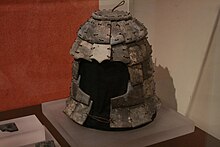

Most of the figures originally held real weapons, which would have increased their realism. The majority of these weapons were looted shortly after the creation of the army or have rotted away. Despite this, over 40,000 bronze items of weaponry have been recovered, including swords, daggers, spears, lances, battle-axes, scimitars, shields, crossbows, and crossbow triggers. Most of the recovered items are arrowheads, which are usually found in bundles of 100 units.[30][62][63] Studies of these arrowheads suggest that they were produced by self-sufficient, autonomous workshops using a process referred to as cellular production or Toyotism.[64] Some weapons were coated with a 10–15 micrometer layer of chromium dioxide before burial that was believed to have protected them from any form of decay for the last 2200 years.[65][66] However, research in 2019 indicated that the chromium was merely contamination from nearby lacquer, not a means of protecting the weapons. The slightly alkaline pH and small particle size of the burial soil most likely preserved the weapons.[67]
The swords contain an alloy of copper, tin, and other elements including nickel, magnesium, and cobalt.[68] Some carry inscriptions that date their manufacture to between 245 and 228 BCE, indicating that they were used before burial.[69]
Precedents and legacy
Only very few figurines are known from before the time of the terracotta army, so that the humanistic and animalistic style may have appeared dramatically new to their contemporaries.[70] In extant archaeology, only rare and very small terracotta warrior figurines are known from the end of the Zhou dynasty in 4th-3rd century BCE, such as the Taerpo horserider, the first known representation of a cavalryman in China, from a military tomb in the Taerpo cemetery near Xianyang (Qin state of the Warring States period).[71][72] The rider wears Central Asian, Scythian-style clothing,[73] and his high pointed nose suggests he is a foreigner,[72] but these early statuettes have been argued to lack the naturalistic and realistic quality of the Qin terracota army.[74]
The terracotta army left a legacy however, as funeral terracotta armies are known from later dynasties, although in a less stern and militaristic style, and with much smaller statuettes, such as the Western Han Yangjiawan terracotta army (195 BCE) or Yangling terracotta army (141 BCE).[75] The human-sized monumental style of the Qin emperor has thus been observed by scholars to be a relatively short-lived artistic phase which would not reappear until the 4-6th centuries CE with the onset of monumental Buddhist sculpture in China.[76]
Scientific research
In 2007, scientists at Stanford University and the Advanced Light Source facility in Berkeley, California, reported that powder diffraction experiments combined with energy-dispersive X-ray spectroscopy and micro-X-ray fluorescence analysis showed that the process of producing terracotta figures colored with Chinese purple dye consisting of barium copper silicate was derived from the knowledge gained by Taoist alchemists in their attempts to synthesize jade ornaments.[77][78]
Since 2006, an international team of researchers at the UCL Institute of Archaeology have been using analytical chemistry techniques to uncover more details about the production techniques employed in the creation of the Terracotta Army. Using X-ray fluorescence spectrometry of 40,000 bronze arrowheads bundled in groups of 100, the researchers reported that the arrowheads within a single bundle formed a relatively tight cluster that was different from other bundles. In addition, the presence or absence of metallic impurities was consistent within bundles. Based on the arrows' chemical compositions, the researchers concluded that a cellular manufacturing system similar to the one used in a modern Toyota factory, as opposed to a continuous assembly line in the early days of the automobile industry, was employed.[79][80]
Grinding and polishing marks visible under a scanning electron microscope have provided evidence for the earliest industrial use of lathes for polishing.[79]
According to a 2022 study, there is statistically no difference between the facial features of terracotta warriors and contemporary Chinese populations, particularly northern and western Chinese populations. However, the issue of terrocotta warriors being potentially deformed and Chinese populations undergoing changes in their facial features due to climate change and dietary factors were not addressed.[81]
Exhibitions

The first exhibition of the figures outside of China was held at the National Gallery of Victoria (NGV) in Melbourne, Australia in 1982.[82]
A collection of 120 objects from the mausoleum and 12 terracotta warriors were displayed at the British Museum in London as its special exhibition "The First Emperor: China's Terracotta Army" from 13 September 2007 to April 2008.[83] This exhibition made 2008 the British Museum's most successful year and made the British Museum the United Kingdom's top cultural attraction between 2007 and 2008.[84][85] The exhibition brought the most visitors to the museum since the King Tutankhamun exhibition in 1972.[84] It was reported that the 400,000 advance tickets sold out so fast that the museum extended its opening hours until midnight.[86] According to The Times, many people had to be turned away, despite the extended hours.[87] During the day of events to mark the Chinese New Year, the crush was so intense that the gates to the museum had to be shut.[87] The Terracotta Army has been described as the only other set of historic artifacts (along with the remnants of the wreck of the RMS Titanic) that can draw a crowd by the name alone.[86]

Warriors and other artifacts were exhibited to the public at the Forum de Barcelona in Barcelona between 9 May and 26 September 2004. It was their most successful exhibition ever.[88] The same exhibition was presented at the Fundación Canal de Isabel II in Madrid between October 2004 and January 2005, their most successful ever.[89] From December 2009 to May 2010, the exhibition was shown in the Centro Cultural La Moneda in Santiago de Chile.[90]
The exhibition traveled to North America and visited museums such as the Asian Art Museum of San Francisco, Bowers Museum in Santa Ana, California, Houston Museum of Natural Science, High Museum of Art in Atlanta,[91] National Geographic Society Museum in Washington, D.C., and the Royal Ontario Museum in Toronto.[92] Subsequently, the exhibition traveled to Sweden and was hosted in the Museum of Far Eastern Antiquities between 28 August 2010 and 20 January 2011.[93][94] An exhibition entitled 'The First Emperor – China's Entombed Warriors', presenting 120 artifacts was hosted at the Art Gallery of New South Wales, between 2 December 2010 and 13 March 2011.[95] An exhibition entitled "L'Empereur guerrier de Chine et son armée de terre cuite" ("The Warrior-Emperor of China and his terracotta army"), featuring artifacts including statues from the mausoleum, was hosted by the Montreal Museum of Fine Arts from 11 February 2011 to 26 June 2011.[96] In Italy, from July 2008 to 16 November 2008, five of the warriors of the terracotta army were displayed in Turin at the Museum of Antiquities,[97] and from 16 April 2010 to 5 September 2010 nine statues including officials, lancers and an archer were displayed at the Royal Palace in Milan at the exhibition entitled "The Two Empires".[98]
Soldiers and related items were on display from 15 March 2013 to 17 November 2013, at the Historical Museum of Bern.[99]
Several Terracotta Army figures were on display, along with many other objects, in an exhibit entitled "Age of Empires: Chinese Art of the Qin and Han Dynasties" at The Metropolitan Museum of Art in New York City from 3 April 2017, to 16 July 2017.[100][101] An exhibition featuring ten Terracotta Army figures and other artifacts, "Terracotta Warriors of the First Emperor," was on display at the Pacific Science Center in Seattle, Washington, from 8 April 2017 to 4 September 2017[102][103] before traveling to The Franklin Institute in Philadelphia, Pennsylvania, to be exhibited from 30 September 2017 to 4 March 2018 with the addition of augmented reality.[104][105]
An exhibition entitled "China's First Emperor and the Terracotta Warriors" was at the World Museum in Liverpool from 9 February 2018 to 28 October 2018.[106]
An exhibition tour of 120 real-size replicas of Terracotta statues was displayed in the German cities of Frankfurt am Main, Munich, Oberhof, Berlin (at the Palace of the Republic) and Nuremberg between 2003 and 2004.[107][108]
Gallery
See also
Notes
- ^ Lu Yanchou; Zhang Jingzhao; Xie Jun; Wang Xueli (1988). "TL dating of pottery sherds and baked soil from the Xian Terracotta Army Site, Shaanxi Province, China". International Journal of Radiation Applications and Instrumentation, Part D. 14 (1–2): 283–286. doi:10.1016/1359-0189(88)90077-5.
- ^ Portal 2007, p. 167.
- ^ a b "Decoding the Mausoleum of Emperor Qin Shihuang". China Daily. 13 May 2010. Archived from the original on 18 December 2019. Retrieved 3 December 2011.
- ^ WILLIAMS, A. R. (12 October 2016). "Discoveries May Rewrite History of China's Terra-Cotta Warriors". National Geographic. Archived from the original on 28 February 2021.
- ^ a b Sima Qian – Shiji Volume 6 Archived 5 October 2013 at the Wayback Machine 《史記•秦始皇本紀》 Original text: 始皇初即位,穿治酈山,及並天下,天下徒送詣七十餘萬人,穿三泉,下銅而致槨,宮觀百官奇器珍怪徙臧滿之。令匠作機駑矢,有所穿近者輒射之。以水銀為百川江河大海,機相灌輸,上具天文,下具地理。以人魚膏為燭,度不滅者久之。二世曰:"先帝後宮非有子者,出焉不宜。" 皆令從死,死者甚眾。葬既已下,或言工匠為機,臧皆知之,臧重即泄。大事畢,已臧,閉中羨,下外羨門,盡閉工匠臧者,無複出者。樹草木以象山。 Translation: When the First Emperor ascended the throne, the digging and preparation at Mount Li began. After he unified his empire, 700,000 men were sent there from all over his empire. They dug down deep to underground springs, pouring copper to place the outer casing of the coffin. Palaces and viewing towers housing a hundred officials were built and filled with treasures and rare artifacts. Workmen were instructed to make automatic crossbows primed to shoot at intruders. Mercury was used to simulate the hundred rivers, the Yangtze and Yellow River, and the great sea, and set to flow mechanically. Above, the heaven is depicted, below, the geographical features of the land. Candles were made of "mermaid"'s fat which is calculated to burn and not extinguish for a long time. The Second Emperor said: "It is inappropriate for the wives of the late emperor who have no sons to be free", ordered that they should accompany the dead, and a great many died. After the burial, it was suggested that it would be a serious breach if the craftsmen who constructed the tomb and knew of its treasure were to divulge those secrets. Therefore, after the funeral ceremonies had completed, the inner passages and doorways were blocked, and the exit sealed, immediately trapping the workers and craftsmen inside. None could escape. Trees and vegetation were then planted on the tomb mound such that it resembled a hill.
- ^ "Chinese terra cotta warriors had real, and very carefully made weapons". The Washington Post. 26 November 2012. Archived from the original on 19 October 2016. Retrieved 19 October 2016.
- ^ Clements 2007, p. 158.
- ^ Shui Jing Zhu Chapter 19 Archived 17 October 2012 at the Wayback Machine 《水經注•渭水》Original text: 秦始皇大興厚葬,營建塚壙於驪戎之山,一名藍田,其陰多金,其陽多美玉,始皇貪其美名,因而葬焉。
- ^ Portal 2007, p. 17.
- ^ Portal 2007, p. 202.
- ^ Qingbo, Duan (2022). "Sino-Western Cultural Exchange as Seen through the Archaeology of the First Emperor's Necropolis". Journal of Chinese History 中國歷史學刊. 7: 67–70. doi:10.1017/jch.2022.25. ISSN 2059-1632. S2CID 251690411.
- ^ Shui Jing Zhu Chapter 19 Archived 17 October 2012 at the Wayback Machine 《水經注•渭水》 Original text: 項羽入關,發之,以三十萬人,三十日運物不能窮。關東盜賊,銷槨取銅。牧人尋羊,燒之,火延九十日,不能滅。Translation: Xiang Yu entered the gate, sent forth 300,000 men, but they could not finish carrying away his loot in 30 days. Thieves from northeast melted the coffin and took its copper. A shepherd looking for his lost sheep burned the place, the fire lasted 90 days and could not be extinguished.
- ^ Sima Qian – Shiji Volume 8 Archived 6 May 2015 at the Wayback Machine 《史記•高祖本紀》 Original text: 項羽燒秦宮室,掘始皇帝塚,私收其財物 Translation: Xiang Yu burned the Qin palaces, dug up the First Emperor's tomb, and expropriated his possessions.
- ^ Han Shu Archived 8 December 2015 at the Wayback Machine《漢書·楚元王傳》:Original text: "項籍焚其宮室營宇,往者咸見發掘,其後牧兒亡羊,羊入其鑿,牧者持火照球羊,失火燒其藏槨。" Translation: Xiang burned the palaces and buildings. Later observers witnessed the excavated site. Afterward, a shepherd lost his sheep which went into the dug tunnel; the shepherd held a torch to look for his sheep, and accidentally set fire to the place and burned the coffin.
- ^ "Royal Chinese treasure discovered". BBC News. 20 October 2005. Archived from the original on 15 December 2006. Retrieved 3 December 2011.
- ^ Agnew, Neville (3 August 2010). Conservation of Ancient Sites on the Silk Road. Getty Publications. p. 214. ISBN 978-1606060131. Archived from the original on 29 March 2023. Retrieved 11 July 2012.
- ^ Glancey, Jonathan (12 April 2017). "The Army that Conquered the World". BBC. Archived from the original on 28 October 2019. Retrieved 10 December 2019.
- ^ O. Louis Mazzatenta. "Emperor Qin's Terracotta Army". National Geographic. Archived from the original on 25 February 2017. Retrieved 22 November 2010.
- ^ The precise coordinates are 34°23′5.71″N 109°16′23.19″E / 34.3849194°N 109.2731083°E)
- ^ Clements 2007, pp. 155, 157, 158, 160–161, 166.
- ^ Ingber, Sasha (20 May 2018). "Archaeologist Who Uncovered China's 8,000-Man Terra Cotta Army Dies At 82". npr.org. Archived from the original on 21 May 2018. Retrieved 21 May 2018.
- ^ "Army of Terracotta Warriors". Lonely Planet. Archived from the original on 21 August 2016. Retrieved 29 July 2016.
- ^ "Discoveries May Rewrite History of China's Terra-Cotta Warriors". 12 October 2016. Archived from the original on 19 March 2019. Retrieved 12 October 2016.
- ^ 73号 Qin Ling Bei Lu (1 January 1970). "Google maps". Archived from the original on 29 May 2014. Retrieved 3 December 2011.
{{cite web}}: CS1 maint: numeric names: authors list (link) - ^ Clements 2007, p. 160.
- ^ a b "The First Emperor". Channel4.com. Archived from the original on 30 September 2010. Retrieved 3 December 2011.
- ^ "Application of geographical methods to explore the underground palace of the Emperor Qin Shi Huang Mausoleum". Retrieved 3 December 2011.[permanent dead link]
- ^ Nature (2003). "Terracotta Army saved from crack up". News@nature. doi:10.1038/news031124-7. Archived from the original on 13 July 2017. Retrieved 3 December 2011.
- ^ Larmer, Brook (June 2012). "Terra-Cotta Warriors in Color". National Geographic. p. 86. Print.
- ^ a b "The Necropolis of First Emperor of Qin". History.ucsb.edu. Archived from the original on 20 November 2011. Retrieved 3 December 2011.
- ^ Lothar Ledderose. A Magic Army for the Emperor. Archived from the original on 10 November 2013. Retrieved 15 September 2017.
- ^ a b "Making the Warrior: The Qin Terracotta Soldiers in *Age of Empires* - The Metropolitan Museum of Art". www.metmuseum.org. 10 July 2017. Retrieved 22 May 2024.
- ^ ""A Magic Army for the Emperor" Lothar Ledderose, Ten Thousand Things. Moduleand Mass Production in Chinese Art, Princeton, Princeton University Press, 1998, pp.51 - 73". Scribd. Archived from the original on 11 September 2021. Retrieved 1 February 2023.
- ^ "The Mausoleum of the First Emperor of the Qin Dynasty and Terracotta Warriors and Horses". China.org.cn. 12 September 2003. Archived from the original on 7 December 2013. Retrieved 3 December 2011.
- ^ Portal 2007.
- ^ "China unearths 114 new Terracotta Warriors". BBC News. 12 May 2010. Archived from the original on 29 March 2023. Retrieved 3 December 2011.
- ^ "Terracotta Accessory Pits". Travelchinaguide.com. 10 October 2009. Archived from the original on 28 September 2018. Retrieved 3 December 2011.
- ^ a b The Terra Cotta Warriors. p. 27. Archived from the original on 29 March 2023. Retrieved 29 March 2023.
{{cite book}}:|work=ignored (help) - ^ Cotterell, Maurice (June 2004). The Terracotta Warriors: The Secret Codes of the Emperor's Army. Inner Traditions Bear and Company. pp. 105–112. ISBN 978-1591430339. Archived from the original on 29 March 2023. Retrieved 29 March 2023.
- ^ Cotterell, Maurice (June 2004). The Terracotta Warriors: The Secret Codes of the Emperor's Army. Inner Traditions Bear and Company. pp. 103–105. ISBN 978-1591430339. Archived from the original on 29 March 2023. Retrieved 29 March 2023.
- ^ a b c Larmer, Brook (June 2012). "Terra-Cotta Warriors in Color". National Geographic. pp. 74–87. Archived from the original on 10 December 2019. Retrieved 10 December 2019.
- ^ lie, Ma (9 September 2010). "Terracotta army emerges in its true colors". China Daily. Archived from the original on 24 January 2020. Retrieved 21 July 2019.
- ^ Imperial Tombs of China. Lithograph Publishing Company. 1995. p. 76.
- ^ a b Nickel, Lukas (October 2013). "The First Emperor and sculpture in China". Bulletin of the School of Oriental and African Studies. 76 (3): 422–427. doi:10.1017/S0041977X13000487. ISSN 0041-977X.
- ^ a b Qingbo, Duan (January 2023). "Sino-Western Cultural Exchange as Seen through the Archaeology of the First Emperor's Necropolis". Journal of Chinese History. 7 (1): 22. doi:10.1017/jch.2022.25. ISSN 2059-1632. S2CID 251690411.
Stimulated by his discovery of the terracotta entertainers at the necropolis, which display a style of sculpture unprecedented in East Asia, as well as by the internal steplike architecture embedded within the emperor's tomb mound, Duan began to explore the influence of West Asian cultures on the Qin. He published some preliminary ideas on this topic in his 2011 monograph on the necropolis, but it was most fully explored in three articles published in successive issues of his university journal, Xibei daxue xuebao, in 2015 (translated here in their entirety).
- ^ Chen, Yumin (November 2013). "Reflections on China's First Collection of Terracotta Acrobats (an exhibition review)". Visual Communication. 12 (4): 497–502. doi:10.1177/1470357213498175. ISSN 1470-3572.
- ^ von Falkenhausen, Lothar (2008). "Action and Image in Early Chinese Art". Cahiers d'Extrême-Asie. 17: 51–91. doi:10.3406/asie.2008.1272. ISSN 0766-1177. JSTOR 44171471. Archived from the original on 30 January 2023. Retrieved 30 January 2023.
- ^ Chen, Yumin (2013). "Reflections on China's First Collection of Terracotta Acrobats (an exhibition review)". Visual Communication. 12 (4): 497–502. doi:10.1177/1470357213498175. ISSN 1470-3572. S2CID 147420437. Archived from the original on 30 January 2023. Retrieved 30 January 2023.
- ^ Qingbo, Duan (2022). "Sino-Western Cultural Exchange as Seen through the Archaeology of the First Emperor's Necropolis". Journal of Chinese History 中國歷史學刊. 7: 21–72. doi:10.1017/jch.2022.25. ISSN 2059-1632. S2CID 251690411.
More than thirty-five years ago [1986], there was a European scholar (German Hafner, 1911–2008) who considered that the art of the terracotta army "originated from Western contact, originated from knowledge of Alexander the Great and the splendor of Greek art." Lukas Nickel of SOAS has put forward a similar proposition.
- ^ Qingbo, Duan (2022). "Sino-Western Cultural Exchange as Seen through the Archaeology of the First Emperor's Necropolis". Journal of Chinese History 中國歷史學刊. 7: 21–72. doi:10.1017/jch.2022.25. ISSN 2059-1632. S2CID 251690411.
The only thing that closely matches the artistic style of the imperial Qin terracotta warriors is the head of a painted pottery figure unearthed in Uzbekistan (...) The way of assembling the head and body for this Kushan figure of a warrior (possibly Saka) was the same as that employed for the Qin terracotta warriors, in that they were fabricated separately, and then the head was inserted into the trunk of the figure.
- ^ "Dr Xiuzhen Li, School of Archaeology, University of Oxford". www.arch.ox.ac.uk.
- ^ "Western contact with China began long before Marco Polo, experts say". BBC News. 12 October 2016. Archived from the original on 16 March 2020. Retrieved 19 October 2023.
- ^ a b Hanink, Johanna; Silva, Felipe Rojas (20 November 2016). "Why China's Terracotta Warriors Are Stirring Controversy". Live Science. Archived from the original on 5 January 2020. Retrieved 5 October 2017. Originally published in Hanink, Johanna; Silva, Felipe Rojas (18 November 2016). "Why there's so much backlash to the theory that Greek art inspired China's Terracotta Army". The Conversation. Archived from the original on 14 September 2020. Retrieved 22 February 2018.
- ^ Bulla, Patrick Michelle (October 2019). "The Qin Dynasty, the Hellenistic Empire, and the Art that May Connect Them: Why Exploring Cultural Connections Matters for Educators and Students of World History". World History Connected. 16 (3). Archived from the original on 6 June 2023. Retrieved 29 October 2023.
- ^ Wilkinson, Darryl (2022), "On the Ontological Significance of Naturalistic Art", Ancient Art Revisited, Routledge, pp. 47–66, doi:10.4324/9781003131038-3, ISBN 978-1-003-13103-8, archived from the original on 19 October 2023, retrieved 10 October 2023
- ^ "China's Terracotta Army: Exploring the Tomb Complex and Values..." Smithsonian Learning Lab. Archived from the original on 8 December 2022. Retrieved 23 October 2023.
- ^ "A Magic Army for the Emperor". Upf.edu. 1 October 1979. Archived from the original on 28 November 2011. Retrieved 3 December 2011.
- ^ Hu, Yungang; Wang, Jingyang; Lan, Dexing (1 May 2021). "Statistical analysis of the differences of head and face features between terracotta warriors and modern multi ethnic groups based on 3D information extraction". IOP Conference Series: Earth and Environmental Science. 783 (1): 012096. Bibcode:2021E&ES..783a2096H. doi:10.1088/1755-1315/783/1/012096. ISSN 1755-1307. S2CID 235387759.
- ^ Hu, Yungang; Lan, Desheng; Wang, Jingyang; Hou, Miaole; Li, Songnian; Li, Xiuzhen; Zhu, Lei (21 March 2022). "Measurement and analysis of facial features of terracotta warriors based on high-precision 3D point clouds". Heritage Science. 10 (1): 40. doi:10.1186/s40494-022-00662-0. ISSN 2050-7445. S2CID 247572024.
- ^ Portal 2007, p. 170.
- ^ Qingbo, Duan (2022). "Sino-Western Cultural Exchange as Seen through the Archaeology of the First Emperor's Necropolis". Journal of Chinese History 中國歷史學刊. 7: 12. doi:10.1017/jch.2022.25. ISSN 2059-1632. S2CID 251690411.
- ^ "Exquisite Weaponry of Terra Cotta Army". Travelchinaguide.com. Archived from the original on 2 March 2020. Retrieved 3 December 2011.
- ^ Marcos Martinón-Torres; Xiuzhen Janice Li; Andrew Bevan; Yin Xia; Zhao Kun; Thilo Rehren (2011). "Making Weapons for the Terracotta Army". Archaeology International. 13: 65–75. doi:10.5334/ai.1316.
- ^ Pinkowski, Jennifer (26 November 2012). "Chinese terra cotta warriors had real, and very carefully made, weapons". The Washington Post. Archived from the original on 19 October 2016. Retrieved 19 October 2016.
- ^ "Terracotta Warriors (Terracotta Army)". China Tour Guide. Archived from the original on 29 October 2019. Retrieved 28 July 2011.
- ^ Zhewen Luo (1993). China's imperial tombs and mausoleums. Foreign Languages Press. p. 102. ISBN 978-7-119-01619-1. Archived from the original on 29 March 2023. Retrieved 28 June 2010.
- ^ Martinón-Torres, Marcos; et al. (4 April 2019). "Surface chromium on Terracotta Army bronze weapons is neither an ancient anti-rust treatment nor the reason for their good preservation". Scientific Reports. 9 (1): 5289. Bibcode:2019NatSR...9.5289M. doi:10.1038/s41598-019-40613-7. PMC 6449376. PMID 30948737.
- ^ "Terracotta Warriors" (PDF). National Geographic. 2009. Retrieved 28 July 2011.[permanent dead link]
- ^ "The First Emperor – China's Terracotta Army – Teacher's Resource Pack" (PDF). British Museum. Archived from the original (PDF) on 15 December 2016. Retrieved 15 June 2017.
- ^ Nickel, Lukas (October 2013). "The First Emperor and sculpture in China". Bulletin of the School of Oriental and African Studies. 76 (3): 416–418. doi:10.1017/S0041977X13000487. ISSN 0041-977X.
From the centuries immediately preceding the Qin Dynasty again we know of only a few depictions of the human figure (...) figures of people and animals were very rare exceptions to the conventional imagery of the Zhou period (...) Depictions of the human figure were not a common part of the representational canon in China before the Qin Dynasty (...) In von Falkenhausen's words, "nothing in the archaeological record prepares one for the size, scale, and technically accomplished execution of the First Emperor's terracotta soldiers". For his contemporaries, the First Emperor's sculptures must have been something dramatically new.
- ^ Nickel, Lukas (October 2013). "The First Emperor and sculpture in China". Bulletin of the School of Oriental and African Studies. 76 (3): 416–418. doi:10.1017/S0041977X13000487. ISSN 0041-977X.
In addition, there are the statuettes of two horse riders which came to light in a late fourth-century bc tomb in Taerpo 塔兒坡, Xianyang, Shaanxi, which are believed to be the earliest depiction of riders in China....
- ^ a b Khayutina, Maria (Autumn 2013). "From wooden attendants to terracotta warriors" (PDF). Bernisches Historisches Museum the Newsletter. 65: 2, Fig.4. Archived (PDF) from the original on 22 October 2023. Retrieved 22 October 2023.
Other noteworthy terracotta figurines were found in 1995 in a 4th-3rd century BCE tomb in the Taerpo cemetery near Xianyang in Shaanxi Province, where the last Qin capital of the same name was located from 350 to 207 BCE. These are the earliest representations of cavalrymen in China discovered up to this day. One of this pair can now be seen at the exhibition in Bern (Fig. 4). A small, ca. 23 cm tall, figurine represents a man sitting on a settled horse. He stretches out his left hand, whereas his right hand points downwards. Holes pierced through both his fists suggest that he originally held the reins of his horse in one hand and a weapon in the other. The rider wears a short jacket, trousers and boots – elements of the typical outfit of the inhabitants of the Central Asian steppes. Trousers were first introduced in the early Chinese state of Zhao during the late 4th century BCE, as the Chinese started to learn horse riding from their nomadic neighbours. The state of Qin should have adopted the nomadic clothes about the same time. But the figurine from Taerpo also has some other features that may point to its foreign identity: a hood-like headgear with a flat wide crown framing his face and a high, pointed nose.
Also in Khayutina, Maria (2013). Qin: the eternal emperor and his terracotta warriors (1. Aufl ed.). Zürich: Neue Zürcher Zeitung. p. cat. no. 314. ISBN 978-3-03823-838-6. - ^ Qingbo, Duan (January 2023). "Sino-Western Cultural Exchange as Seen through the Archaeology of the First Emperor's Necropolis" (PDF). Journal of Chinese History. 7 (1): 26 Fig.1, 27. doi:10.1017/jch.2022.25. S2CID 251690411. Archived (PDF) from the original on 22 October 2023. Retrieved 22 October 2023.
In terms of formal characteristics and style of dress and adornment, the closest parallels to the Warring States-period Qin figurines are found in the Scythian culture. Wang Hui 王輝 has examined the exchanges between the cultures of the Yellow River valley and the Scythian culture of the steppe. During a 2007 exhibition on the Scythians in Berlin, there was a bronze hood on display labeled a "Kazakh military cap." This bronze hood and the clothing of the nomads in kneeling posture [also depicted in the exhibition] are very similar in form to those of the terracotta figurines from the late Warring States Qin-period tomb at the Taerpo site (see Figure 1). The style of the Scythian bronze horse figures and the saddle, bridle, and other accessories on their bodies are nearly identical to those seen on the Warring States-period Qin figurines and a similar type of artifact from the Ordos region, and they all date to the fifth to third centuries BCE.
- ^ Nickel, Lukas (October 2013). "The First Emperor and sculpture in China". Bulletin of the School of Oriental and African Studies. 76 (3): 416–421. doi:10.1017/S0041977X13000487. ISSN 0041-977X.
- ^ Chong, Alan (1 January 2011). Terracotta Warriors: The First Emperor and His Legacy. Asian Civilisations Museum. Archived from the original on 21 December 2023. Retrieved 22 October 2023.
- ^ Qingbo, Duan (9 April 2019). "Persian and Greek Participation in the making of China's First Empire (Video timing: 45:00-47:00)". Video of 2018 conference at UCLA. Archived from the original on 27 October 2023. Retrieved 25 October 2023.
- ^ Bertrand, Loïc; Robinet, Laurianne; Thoury, Mathieu; Janssens, Koen; Cohen, Serge X.; Schöder, Sebastian (26 November 2011). "Cultural heritage and archaeology materials studied by synchrotron spectroscopy and imaging". Applied Physics A. 106 (2): 377–396. doi:10.1007/s00339-011-6686-4. S2CID 95827070.[permanent dead link]
- ^ Liu, Z.; Mehta, A.; Tamura, N.; Pickard, D.; Rong, B.; Zhou, T.; Pianetta, P. (November 2007). "Influence of Taoism on the invention of the purple pigment used on the Qin terracotta warriors". Journal of Archaeological Science. 34 (11): 1878–1883. Bibcode:2007JArSc..34.1878L. CiteSeerX 10.1.1.381.8552. doi:10.1016/j.jas.2007.01.005. S2CID 17797649.
- ^ a b Rees, Simon (6 March 2014). "Chemistry unearths the secrets of the Terracotta Army". Education in Chemistry. Vol. 51, no. 2. Royal Society of Chemistry. pp. 22–25. Archived from the original on 17 May 2017. Retrieved 29 March 2014.
- ^ Martinón-Torres, Marcos; Li, Xiuzhen Janice; Bevan, Andrew; Xia, Yin; Zhao, Kun; Rehren, Thilo (20 October 2012). "Forty Thousand Arms for a Single Emperor: From Chemical Data to the Labor Organization Behind the Bronze Arrows of the Terracotta Army" (PDF). Journal of Archaeological Method and Theory. 21 (3): 534. doi:10.1007/s10816-012-9158-z. S2CID 163088428. Archived (PDF) from the original on 22 September 2017. Retrieved 14 November 2018.
- ^ Hu, Yungang; Lan, Desheng; Wang, Jingyang; et al. (2022). "Measurement and analysis of facial features of terracotta warriors based on high-precision 3D point clouds". Heritage Science. 10 (40). doi:10.1186/s40494-022-00662-0.
- ^ Jefferson, Dee (16 December 2018). "China's terracotta warriors will visit Melbourne for National Gallery of Victoria's Winter Masterpieces series". Arts. ABC News. Archived from the original on 8 November 2020. Retrieved 18 December 2018.
- ^ "The First Emperor: China's Terracotta Army". British Museum. Archived from the original on 11 August 2011. Retrieved 15 June 2017.
- ^ a b Higgins, Charlotte (2 July 2008). "Terracotta army makes British Museum favourite attraction". The Guardian. London. Archived from the original on 31 March 2019. Retrieved 25 May 2010.
- ^ "British Museum sees its most successful year ever". Best Western. 3 July 2008. Archived from the original on 11 October 2008.
- ^ a b "British Museum ponders 24-hour opening for terracotta warriors". CBC News. 22 November 2007. Archived from the original on 13 August 2016. Retrieved 29 July 2016.
- ^ a b Whitworth, Damian (9 July 2008). "Is the British Museum the greatest museum on earth?". The Times. London. Archived from the original on 16 June 2011. Retrieved 25 May 2010.
- ^ DesarrolloWeb (19 April 2007). "Los guerreros de Xian, en el Forum de Barcelona". Guiarte.com. Archived from the original on 28 March 2018. Retrieved 3 December 2011.
- ^ "Guerreros de Xian". Futuropasado.com. Archived from the original on 19 March 2019. Retrieved 3 December 2011.
- ^ "Llegan a Chile los legendarios Guerreros de Terracota de China". Latercera.com. Archived from the original on 21 October 2011. Retrieved 3 December 2011.
- ^ "Record-Breaking Terracotta Army Exhibition at Atlanta museum". Archived from the original on 11 July 2011. Retrieved 16 January 2010.
- ^ "ROM's terracotta warriors show a blockbuster". CBC. 6 January 2011. Archived from the original on 10 January 2011. Retrieved 16 January 2011.
- ^ "China's Terracotta Army, Stockholm, Sweden, Reviews". Archived from the original on 29 March 2023. Retrieved 20 January 2010.
- ^ "World Famous Terracotta Army Arrives in Stockholm for Exhibition at Ostasiatiska Museum". Archived from the original on 22 November 2008. Retrieved 20 January 2010.
- ^ "Terracotta warriors, Picassos heading to Sydney". ABC News. 14 October 2010. Archived from the original on 12 November 2012. Retrieved 23 January 2011.
- ^ "Empereur Guerrier De Chine Et Son Armee De Terre Cuite". Mbam.qc.ca. Archived from the original on 30 September 2011. Retrieved 3 December 2011.
- ^ "Il Celeste Impero. Guerrieri di terracotta a Torino – Il Sole 24 ORE". Archived from the original on 21 January 2015. Retrieved 21 January 2015.
- ^ "Esercito di Terracotta: dalla Cina a Palazzo Reale di Milano – NanoPress Viaggi". 9 April 2010. Archived from the original on 1 April 2019. Retrieved 21 January 2015.
- ^ "Die Terrakotta-Krieger sind da". Der Bund. 22 February 2013. Archived from the original on 22 June 2015. Retrieved 21 June 2015.
- ^ Age of Empires: Chinese Art of the Qin and Han Dynasties Archived 11 April 2017 at the Wayback Machine Metropolitan Museum of Art
- ^ 'Age of Empires: Chinese Art of the Qin and Han Dynasties (221 B.C.–A.D. 220)' Review: Treasures of Nation-Building Archived 12 April 2017 at the Wayback Machine Wall Street Journal
- ^ Upchurch, Michael (7 April 2017). "'Terracotta Warriors' exhibit makes grand entrance at Pacific Science Center". Seattle Times. Archived from the original on 1 July 2017. Retrieved 10 July 2017.
- ^ "Terracotta Warriors of the First Emperor". Pacific Science Center. Archived from the original on 11 July 2017. Retrieved 10 July 2017.
- ^ "Why the Terracotta Warriors are so special, and how to see them in Philly". Philly.com. Archived from the original on 2 October 2017. Retrieved 3 October 2017.
- ^ Hurdle, Jon (29 September 2017). "Arming China's Terracotta Warriors – With Your Phone". The New York Times. ISSN 0362-4331. Archived from the original on 3 October 2017. Retrieved 3 October 2017.
- ^ "World Museum, Liverpool museums". www.liverpoolmuseums.org.uk. Archived from the original on 21 December 2017. Retrieved 5 January 2018.
- ^ "Einmarsch der Chinesen". Der Tagesspiegel (in German). 16 January 2004. Archived from the original on 5 September 2019. Retrieved 5 September 2019.
- ^ "Tschüss Berlin! Terrakotta-Krieger des Kaisers von China ziehen weiter". Berliner Morgenpost (in German). Deutsche Presse-Agentur. 25 July 2004. Archived from the original on 5 September 2019. Retrieved 5 September 2019.
Bibliography
- Clements, Jonathan (18 January 2007). The First Emperor of China. Sutton. ISBN 978-0-7509-3960-7.
- Debaine-Francfort, Corinne (1999). The Search for Ancient China. 'New Horizons' series. London: Thames & Hudson. ISBN 978-0-500-30095-4.
- Dillon, Michael (1998). China: A Historical and Cultural Dictionary. Durham East Asia series. Richmond, Surrey: Curzon. ISBN 978-0-7007-0439-2.
- Portal, Jane (2007). The First Emperor: China's Terracotta Army. Harvard University Press. ISBN 978-0-674-02697-1.
- Ledderose, Lothar (2000). "A Magic Army for the Emperor". Ten Thousand Things: Module and Mass Production in Chinese Art. The A.W. Mellon Lectures in the Fine Arts. Princeton, NJ: Princeton University Press. ISBN 978-0-691-00957-5.
- Perkins, Dorothy (2000). Encyclopedia of China: The Essential Reference to China, Its History and Culture. Facts On File. ISBN 978-0-8160-4374-3.
External links
- UNESCO description of the Mausoleum of the First Qin Emperor
- Emperor Qinshihuang's Mausoleum Site Museum (official website)
- People's Daily article on the Terracotta Army
- OSGFilms Video Article : Terracotta Warriors at Discovery Times Square
- Tomb of the First Emperor of China by Professor Anthony Barbieri, UCSB
- Emperor's Ghost Army PBS Nova
- China's Terracotta Warriors Documentary produced by the PBS Series Secrets of the Dead
- 3rd-century BC sculptures
- 1974 archaeological discoveries
- 1974 in China
- Archaeological discoveries in China
- Infantry units and formations
- Military and war museums in China
- Archaeological museums in China
- Qin dynasty
- World Heritage Sites in China
- Tourist attractions in Xi'an
- Terracotta sculptures
- Museums in Xi'an
- AAAAA-rated tourist attractions
- Military art
- Funerary art
- Qin Shi Huang
- National first-grade museums of China
- Sculptures of horses




